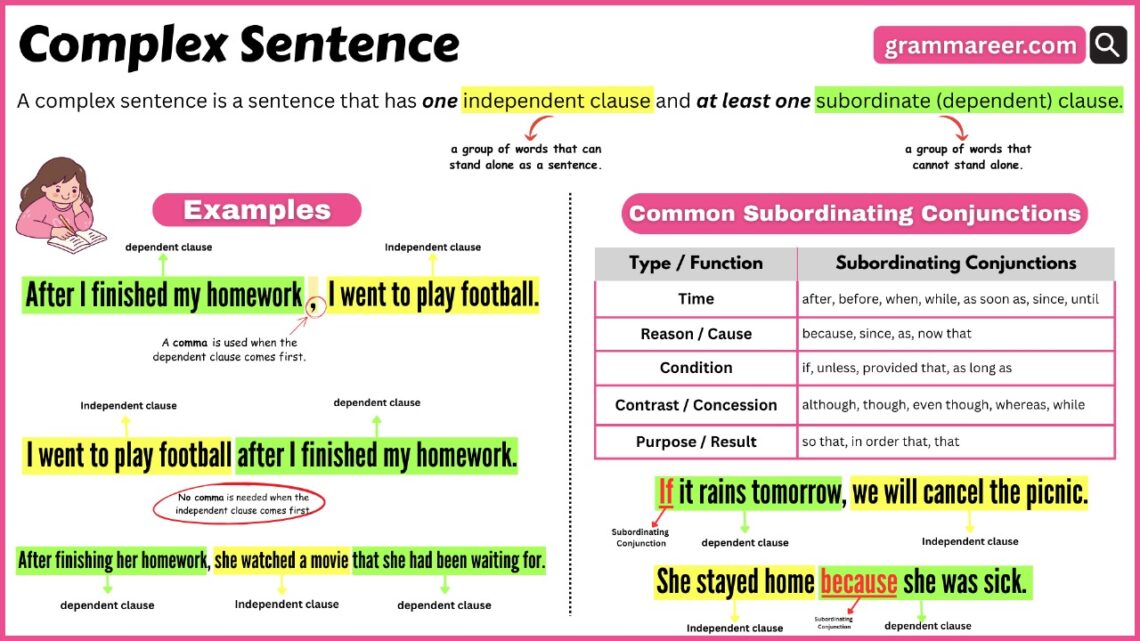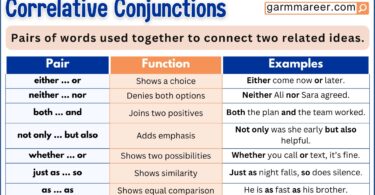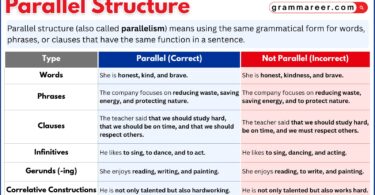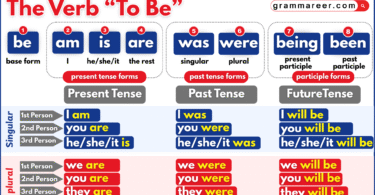Ready to take your English to the next level after learning about simple sentences? Complex sentences are up next! Don’t worry—we’ll make it easy.
In this article, you’ll learn what complex sentences mean, how to put them together, and ways to use them effectively. Plus, there are lots of examples and practice questions to help you feel confident with this new skill.
Table of Contents
What Is a complex sentence?
A complex sentence gives more information on your main point by joining one independent clause with at least one dependent clause. Complex sentences make it easier to give background information.
For Example:
- I stayed inside because it was too cold.
- (shows how the independent clause I stayed inside can stand alone, while the dependent clause because it was too cold needs the other part to make sense.)
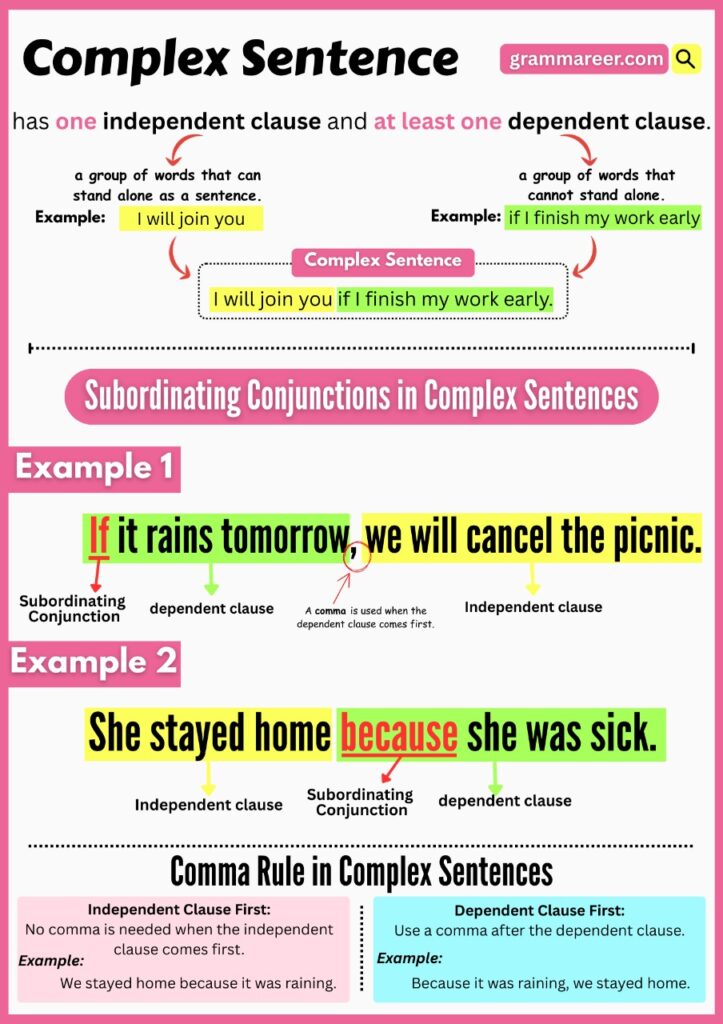
Definition of a Complex Sentence
A complex sentence is a sentence that contains one independent clause (a complete thought) and at least one dependent clause (an incomplete thought) joined by a subordinating conjunction or a relative pronoun.
Points to Keep in Mind When Forming Complex Sentences
Let’s see what you should focus on when making a complex sentence and which points are essential to keep in mind:
Complex sentence structure
A complex sentence is made by joining at least one dependent clause to an independent clause. The independent clause is a complete thought, it can stand alone effortlessly. The dependent clause can’t stand alone cause it needs the independent one to make sense.
Example:
- Independent clause: He finished his homework.
- Dependent clause: Before the movie started.
- Complex sentence: Before the movie started, he finished his homework.
Dependent clauses add detail, context, and depth to your writing.
Commas in complex sentences
Punctuation in complex sentences depends on where the dependent clause goes. If it comes first, put a comma before the independent clause. If it comes after, you usually skip the comma. But there are exceptions—sometimes you might use a comma for style, especially if the dependent clause is short and at the end.
Making Complex Sentences with Subordinating Conjunctions
When you write a complex sentence, the dependent clause often starts with a subordinating conjunction. These little words connect your two ideas and show how they relate—whether it’s about time, cause, contrast, condition, reason, or place.
Here are some common examples:
| Common usage | Subordinating conjunction examples |
| Time | when, while, before, after, until Example: We need to finish the plans before Sarah comes back from vacation. |
| Cause/Effect | because, since, so that Example: He spoke slowly so that everyone could follow along. |
| Condition | if, unless, only if Example: We’ll win the trophy if we score in the last match. |
| Contrast | although, whereas, while Example:Although it was crowded, service was quick. |
| Place | where, wherever Example: They worked in a lab where the air was carefully controlled. |
What’s the difference between a complex sentence and a simple sentence?
It really comes down to what you want your writing to do. Complex sentences let you show more about how ideas connect. They add detail, depth, and a nice flow to your writing. On the other hand, simple sentences are short, clear, and perfect for making key points stand out.
Quick guide:
- Complex sentence: One independent clause + at least one dependent clause → Adds more info and makes your writing flow smoothly.
- Simple sentence: One independent clause → Shares one complete thought, but too many in a row can make your writing sound choppy.
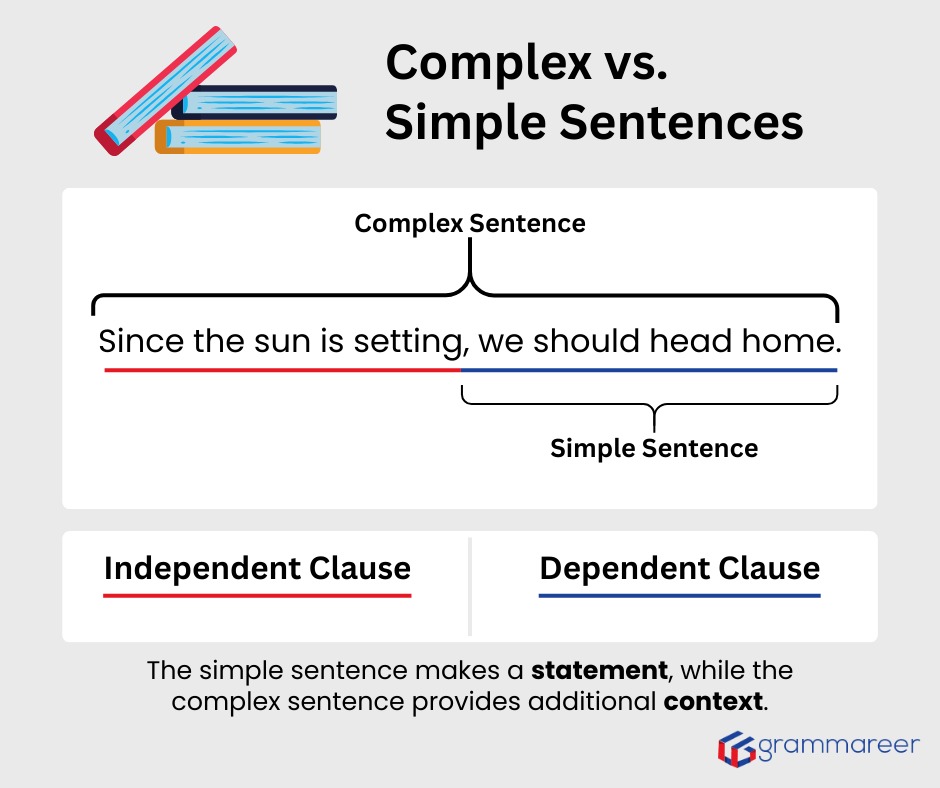
Why We Use Complex Sentences?
Complex sentences are important because they help you connect ideas and explain them more clearly. Rather than using many short sentences, you can join them to show relationships like cause, time, or contrast. This makes your writing flow better and sound more natural.
For example:
- Simple sentences: The sun set. We lit a fire.
- Complex sentence: We lit a fire after the sun set.
See how the complex sentence keeps the meaning but connects the ideas more smoothly? You can also use them to add detail:
- I kept running even though I was tired.
They make your writing richer, easier to follow, and more engaging.
Examples of Complex Sentences
Let’s look at a few ways you can form complex sentences.
1. Complex Sentences with a Subordinating Conjunction at the Beginning
When the subordinating conjunction comes first, the dependent clause is placed before the main clause. Remember to use a comma after the first part.
- If it rains tomorrow, we’ll have to cancel the picnic.
- When the movie ended, we went out for ice cream.
- Although she was tired, Maria stayed up to finish her homework.
Pattern: Subordinating conjunction + dependent clause, main clause
2. Complex Sentences with a Subordinating Conjunction in the Middle
Here, the main clause comes first and the subordinating conjunction connects it to the dependent clause. No comma is needed in this case.
- I stayed at home because I wasn’t feeling well.
- We will go swimming if the sun comes out.
- She kept smiling even though she was nervous.
Pattern: Main clause + subordinating conjunction + dependent clause
3. Complex Sentences with a Relative Clause as the Dependent Clause
A relative clause gives extra information about a noun in the sentence. It usually starts with words like who, which, or where, and is set off with commas.
- My cousin, who lives in Canada, is visiting us next month.
- The park, where we used to play as kids, is now closed.
- The teacher, who taught me in grade 5, inspired me to become a writer.
Pattern: Main clause (with extra detail added through a relative clause)
FAQs
A complex sentence has at least one main part (independent clause) and one extra part (dependent clause) that adds detail. They’re usually joined together with a word like because, if, or when.
Dictionaries all agree—a complex sentence has one main clause and one or more subordinate clauses. The main clause can stand alone, but the other parts can’t.
1. Always have one independent clause and one subordinate clause.
2. Use a subordinating conjunction (like because, although, if) to join them.
3. If the conjunction comes first, use a comma after the dependent clause. If it’s in the middle, no comma is needed.
4. You can also use a relative clause (starting with who, which, where) to add detail.
After we finish school, we’ll go to the park.
The professor, whom I met yesterday, liked my project idea.
I’ll leave as soon as my brother picks me up.
My brother, who studied mechanical engineering, works at BOSCH.
We’ll go camping if the weather is good.
Final Thoughts
As we learned, complex sentences join one main idea with another part that gives extra information. They help explain things more clearly and make your writing flow better. Using them is a simple way to make your sentences sound more complete and connected.
You May Also Like
What are Prepositional Phrases?
100 Prefixes and Suffixes
Adverbial Phrase with Examples
Verb Conjugation with Explanation

